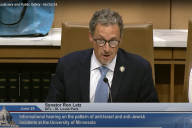You have /5 articles left.
Sign up for a free account or log in.
While nearly all Latino young adults know that a college education is important, far fewer know anything at all about financial aid or the cost of college, according to a recent survey of 18-24 year old Latinos in California.
The Tomas Rivera Policy Institute surveyed 400 Latinos -- 200 who had attended at least some college, and 200 who had not -- and found that over half mistakenly believed that only U.S. citizens could apply for financial aid. A quarter of those surveyed thought that their parents had to be U.S. citizens for them to apply for financial aid.
A 2004 survey by the institute found that 43 percent of Latinos who did not attend college could not name a single source of financial aid, such as scholarships, grants, loans or work study.
“Conversations about financial aid don’t take place at every level of a high school,” said Estela Zarate, director of education policy research at the institute. Zarate added that students talk college and financial aid with counselors and in Advanced Placement classes, but that it should be more “common vocab” in all classes.
Only 38 percent of the respondents felt that the benefits of college outweigh the costs, a belief that may be fueled by widespread misperceptions about college costs, extending even beyond financial aid.
Only 17 percent of respondents could accurately estimate the cost -- including lost working time -- of attending a University of California institution, and only 14 percent could do it for a California State University institution. Forty-seven percent were able to accurately estimate the cost of a community college, aided in part by the fact that half of the respondents who had attended at least some college had attended or were now enrolled in community colleges.
Incurring debt was one of the major concerns of young Latinos who did not attend college. One-quarter of respondents thought that grades were a consideration when applying for a loan. Sixty percent of respondents said that their parents own a home, but only half of those thought their parents would be willing to mortgage it to pay for college.
Additionally, 30 percent said they would go to a commercial bank if they were going to take a loan, rather than taking advantage of government-subsidized loans. Deborah A. Santiago, vice president for policy and research at Excelencia in Education, which focuses on Hispanic higher education issues, said that Latinos are often reticent to take loans because they generally think in terms of the loans they know -- for cars or homes -- which they must start paying immediately.
She added that, because a lot of the Latino students at community colleges and less selective institutions prefer to pay as they go, those institutions often don’t make big efforts to inform prospective students about loans.
Eighty percent of the present and former college students surveyed had heard of Pell Grants, compared to only 49 percent of those who had never been to college. The survey report adds that, while the terms “loan” and “scholarship” have exact parallels in Spanish, “grant” does not have a single, exact translation, so it has to be explained in very basic terms.
The survey also found that most of the families that filled out a FAFSA form did so through collaboration with parents and child. Santiago said that first generation students often take the lead in filling out a FAFSA form, which can create “an interesting social dynamic” as a child delves into family finances. “Both students and parents need to get financial aid information,” Santiago said, “and it needs to be bilingual, so they can both learn at the same time.”
Zarate added that the students surveyed tended to weigh the benefits of college in a very concrete way, by comparing the opportunity cost of losing work time, against the increased wages they might earn as a college graduate. Zarate said that students need to be told about other factors that might tip the scales toward college. “We don’t talk about the very real increased status in society,” Zarate said. “We don’t have enough solid information to be able to talk about it.”








